Physical Address
304 North Cardinal St.
Dorchester Center, MA 02124
Low back pain (LBP) and neck pain represent two of the five leading causes of medical disability worldwide. More than 75% of patients reporting spine pain are between 18 and 65 years old, thereby adding to the burden through lost productivity and wages. Although the prevalence of LBP varies greatly throughout the literature, some lifetime prevalence estimates are as high as 84%–90%. , The five year recurrence rate of LBP may be as high as 69%. The lifetime prevalence rate of neck pain has been estimated to be approximately 67%. , In 2016, LBP and neck pain expenditures were estimated at $134.5 billion, an increase of 44.4% from 2013.
The spine is usually composed of seven cervical, 12 thoracic, and five lumbar vertebrae. The z-joints are paired structures situated posterolateral to the vertebral body. In conjunction with the intervertebral disk, they make up what is commonly known as “the three-joint complex.” Together, these joints support and stabilize the spine and prevent injury by limiting motion in all planes. The lumbar z-joints are diarthrodial synovial joints formed from the superior articular process of one vertebra and the inferior articular process of the vertebra above. The volume capacity of these joints is approximately 1–1.5 mL in the lumbar region and 0.5–1.0 mL in the cervical region. The articular surfaces are covered by hyaline cartilage and contain a fibrous capsule. The fibrous capsule is approximately 1 mm thick and forms mostly collagenous tissue arranged in a transverse fashion to provide resistance to forward flexion. , The superior and inferior joint borders are formed by the fibrous capsule. There is also a small meniscoid structure inside the joint composed of connective tissue rim or adipose tissue. In the lumbar spine, the multifidus muscle serves as the posterior joint border, and the ligamentum flavum replaces the fibrous capsule at the anterior border. , The position of the joint relative to the sagittal and coronal planes helps determine the role the joint plays in protecting the spine against excessive motion. Joints oriented parallel to the sagittal plane (e.g. upper lumbar spine) provide little resistance to backward and forward shearing forces, but limit excess rotation, flexion, and extension. Joints oriented closer to the coronal plane (e.g. thoracic spine and lower lumbar spine) will allow less rotation, flexion, and extension but protect against shearing forces. The cervical z-joints are inclined at approximately 45° from the horizontal plane and angled 85° from the sagittal plane. This alignment prevents excessive anterior translation and assists the disks in weight bearing. ,
The mamillo-accessory ligament (MAL) is a fibrous connective band that extends from the mammary process to the accessory process ( Fig. 31.1 ). The importance of the MAL lies in the fact that they provide a fibrous tunnel through which the lumbar medial branch of the T12–L4 dorsal rami course. This protects the medial branch but may interfere with nerve anesthetization during medial branch blocks and neurotomy during radiofrequency ablation. The MAL can also become ossified, becoming a hypothetical source of medial branch entrapment, particularly at lower lumbar levels.
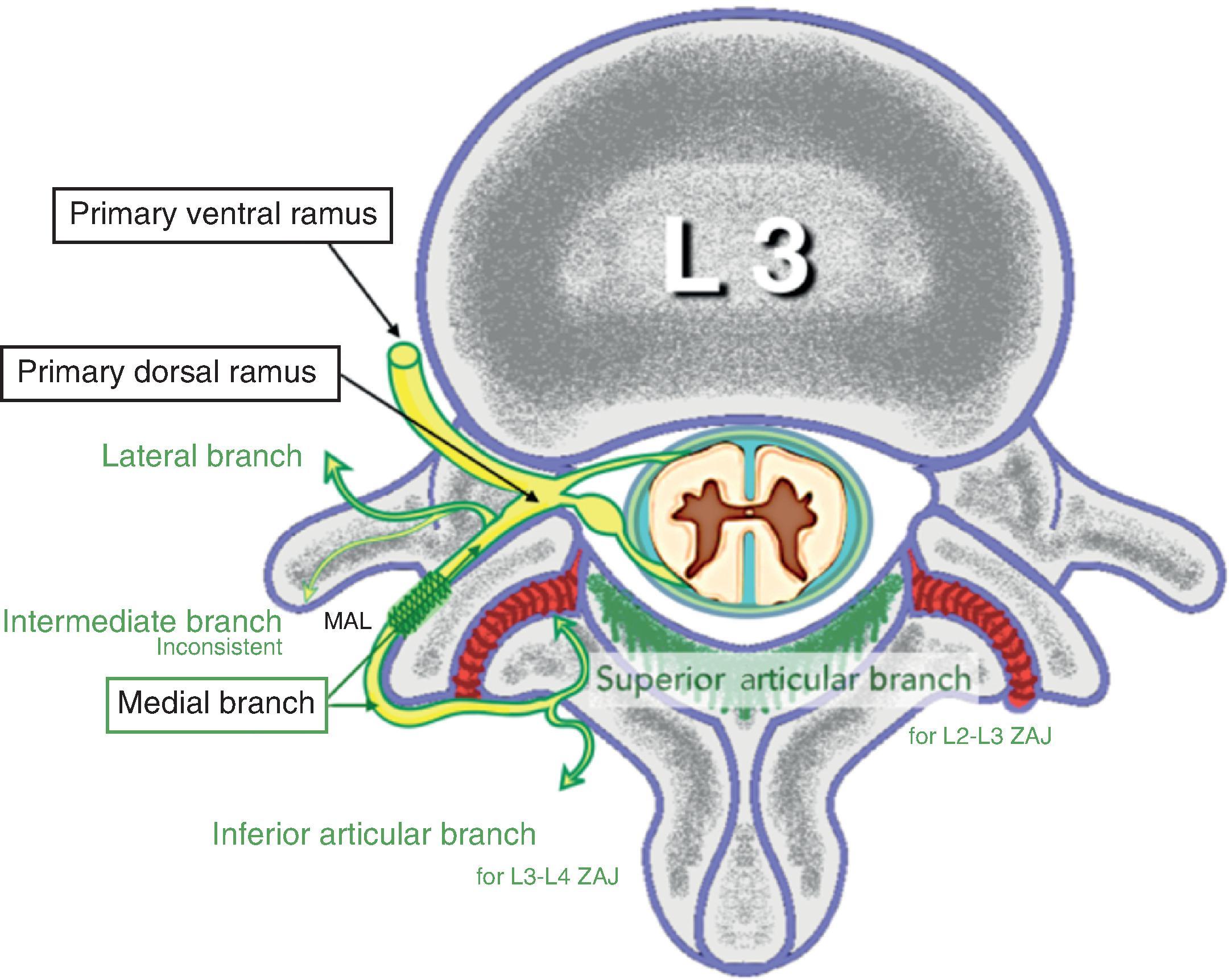
The medial branch of the posterior rami supplies sensory and proprioceptive innervation to the facet joint. Each exiting spinal nerve splits into ventral and dorsal rami. The ventral ramus is the largest of the two branches and is the primary source of motor and sensory fibers. The posterior ramus divides into the lateral, intermediate, and medial branches. In the lumbar region, the lateral branch innervates the paraspinal muscles, thoracolumbar fascia, and sacroiliac joint, and supplies variable sensory fibers to the skin overlying the spinous processes. The small intermediate branch supplies the longissimus muscle. The medial branch is the largest branch of the posterior primary ramus and innervates the lumbar z-joint, multifidus muscle, interspinal muscle and ligament, and periosteum of the neural arch. Each medial branch gives rise to an ascending and a descending branch, innervating half of two adjacent z-joints. Therefore to block sensory input from a single z-joint, two adjacent medial branches must be anesthetized.
Facet joints are imbued with rich innervation containing encapsulated (Ruffini-type endings, Pacinian corpuscles), unencapsulated, and free nerve endings. In addition to being a potential pain generator, the z-joint capsule is thought to serve in a proprioceptive capacity as well, as evidenced by the presence of low threshold, rapidly adapting mechanosensitive neurons. In addition to substance P and calcitonin gene-related peptide, a substantial percentage of nerve endings in the facet capsules contain neuropeptide Y, which is indicative of the presence of sympathetic efferent fibers. Nerve fibers have been found in subchondral bone and intraarticular inclusions of facet joints, thus signifying that facet-mediated pain may originate in structures besides the joint capsule. Inflammatory mediators, such as prostaglandins, and the inflammatory cytokines interleukin-6 and tumor necrosis factor-α have been found in facet joint cartilage and synovial tissue in degenerative lumbar spinal disorders.
The lumbar facet joints are aligned laterally to the sagittal plane and vary in angle. In an anatomic study published in 1940 by Horwitz and Smith, the authors found that the L4–5 z-joints tended to be more coronally positioned (almost 70° with respect to the sagittal plane), whereas the L2–3 and L3–4 joints were likely to be oriented more parallel (<40°) to the sagittal plane. In posterior studies, , investigators have found that the upper lumbar facet joints (T12–L2) are oriented closer to the midsagittal plane of the vertebral body (mean range, 26° to 34°), whereas the lower facet joints tend to be oriented away from the plane (40° to 56°). Approximately 80% of the facet joints are curved in the upper lumbar spine and 20% are flat. In the lower lumbar spine, these numbers are reversed. Studies by Grobler and colleagues and Boden and associates found a positive association between degenerative spondylolisthesis and more sagittally oriented lower lumbar facet joints. The inferior articular processes of L5 combine with the superior articular processes of the sacrum to form the L5–S1 facet joints.
Sensory innervation of the facet joints is derived from the medial branches arising from the posterior primary rami at the same level and the level above the facet joint. , The medial branches of L1–L4 run across their respective transverse processes one level below the named spinal nerve (e.g. L4 crosses the transverse process of L5) and traverse the dorsal leaf of the intertransverse ligament at the base of the transverse process. The nerve then proceeds along the junction of the superior articular and transverse processes, courses underneath the MAL, and splits into multiple branches as it crosses the vertebral lamina ( Fig. 31.1 ). Calcification of the MAL can be a source of nerve entrapment, most commonly occurring at L5 (20%) and L4 (10%). At L5, the dorsal ramus itself is amenable to blockade. , Some authors have claimed that a branch from the S1 nerve root can run cephalad to supply a portion of the L5–S1 facet joint, although this is controversial. , It is important to appreciate the distances between the posterior rami proper and the medial branch (since the objective of diagnostic blocks and neurotomy is to target the medial branch selectively). Shuang found that the distance between the branch point of the dorsal ramus and the upper edge of the root of the transverse process (i.e. target point for the medial branch) averaged 3.5 (SD 1.2) mm, 3.6 (SD 1.4) mm, 3.5 (SD 1.3) mm, 3.4 (SD 1.2) mm, and 1.9 (SD 0.9) for L1 to L5, respectively. The L5 distance was significantly shorter than the L1–L4 distance. The extensive spread of local anesthetic in soft tissue (i.e. 0.5 mL covers an area of 6 cm 2 ) highlights the lack of specificity for medial branch blocks.
The thoracic z-joints are vertically oriented, with the anterior portion located more cephalad. , , The frontal orientation permits lateral flexion at the expense of axial rotation. In the low thoracic spine, the angle transitions from a predominantly frontal orientation to the characteristic sagittal orientation of the lumbar facets. This transition generally occurs between T11–12 and T12–L1. , A study by Masharawi showed that thoracolumbar facet joints were positioned in an oblique plane. In the transverse plane, facets T1–T11 were positioned with an anterior inclination of approximately 25° to 30° from the frontal plane. The transverse orientation of lower thoracic facet joints is highly variable. Unlike the lumbar facet joints, where tropism is unusual, , asymmetry is the rule rather than the exception in the thoracic spine, with the right side generally oriented more vertically and frontally than the left. The normal angles of z-joints gradually increase as they transition downwards toward the lumbar spine by converging to the frontal plane, more so in the sagittal than the transverse plane.
Sensory innervation of the thoracic facets is comparable to that in the lumbar spine, with innervation derived from the medial branch at the same level and level above. Exceptions to this rule sometimes occur at the uppermost thoracic z-joints, whereby the medial branches from C7 and C8 may travel caudad to levels as low as T3. In a cadaveric study by Chua and Bogduk, the authors showed that the thoracic medial branches assume different courses depending on the level. This study asserts that the T1–3 and T9–10 medial branches can be found on the superolateral edge of the transverse process of the subjacent vertebrae (T2–4 and T10–11, respectively). The relationship with osseous structures has implications for treatment. In the mid-thoracic region, the T4–T8 levels contain substantial inter and intraspecimen variability, with facet joint innervation often arising directly from the dorsal ramus rather than the medial branch and frequently traversing the intertransverse space without consistent bone contact.
Because the thoracic medial branches also swing laterally to circumvent the multifidus muscle, motor stimulation of the multifidus muscle cannot be used reliably to confirm needle placement during radiofrequency (RF) treatment. In none of the 84 medial branch dissections did the authors find the nerve crossing the junction between the superior articular process and the transverse process, as occurs in the lumbar spine. Instead, the superolateral corner of the transverse process was noted to be a more accurate target point for diagnostic blockade and denervation ( Fig. 31.2 ). A recent study suggested that the posterior rami in the thoracic spine may send a branch, termed the “descending branch,” to the facet joint before the bifurcations of the medial and lateral branches.
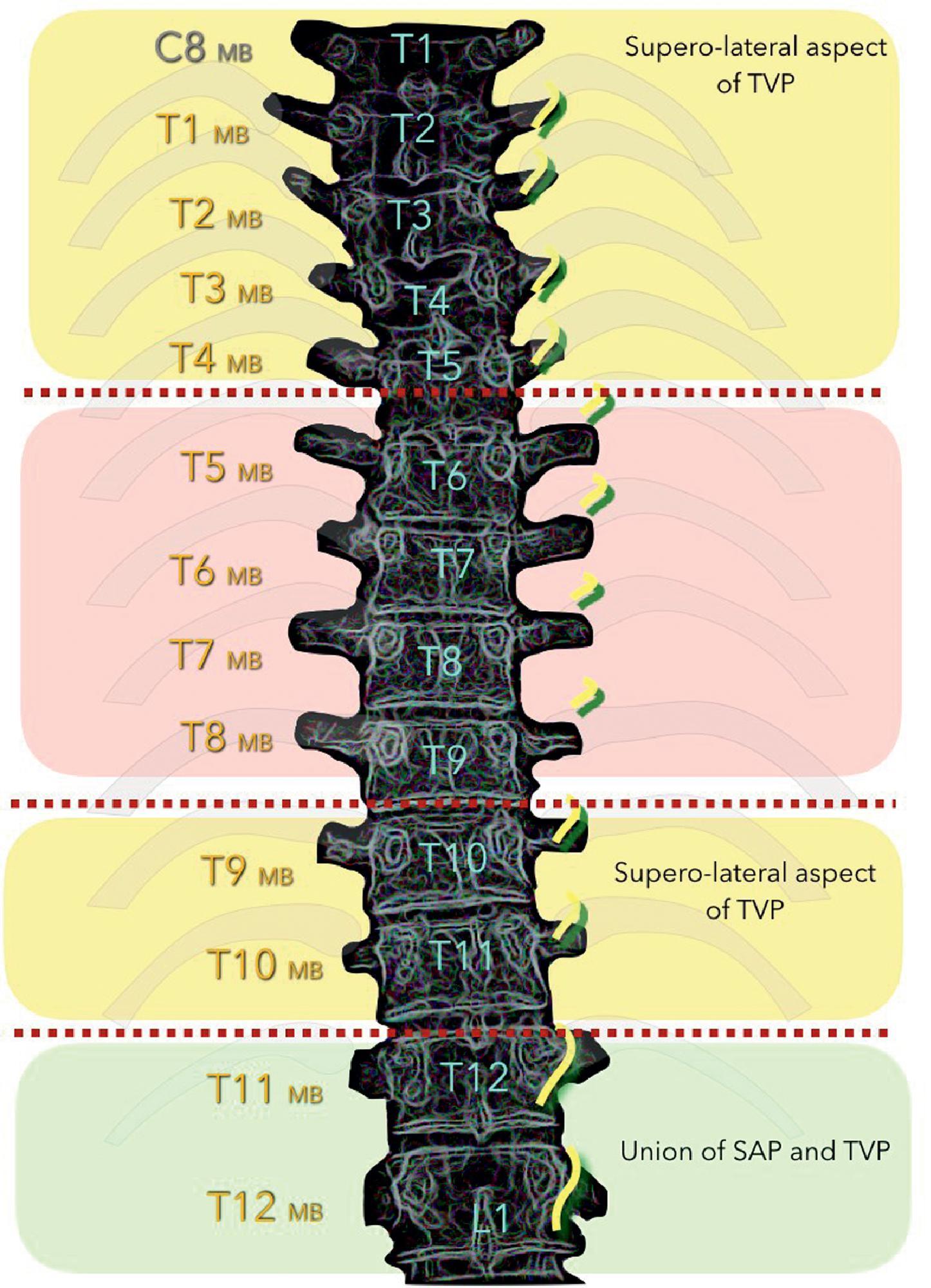
To facilitate the complex motions of the neck, the position and shape of the cervical z-joints change greatly from the base of the occiput to the cervicothoracic junction. , , The occiput sits on the C1 articular processes in an orientation nearly parallel to the axial plane. The superior articular process at C3 faces posteromedially, with a 70° angle in the sagittal plane and a 45° angle in the transverse plane. The relative position of the C2–3 facet inhibits rotation and serves to anchor the C2 vertebra as a rotational pivot for the atlantoaxial joint (C1–2). Between C3–4 and C7–T1, the facet joint orientation transitions to the more posterolateral position of the C7 superior articular process. The most frequent site of this transition is the C5–6 joint. The position of the z-joints at this level allows flexion, extension, rotation, and lateral bending. Because of the enhanced mobility of this segment, the C5–6 level is also the most prone to facet dislocations and spondylosis. The shapes of the C3–6 facet joints tend to be round and almost flat, whereas the C6–T1 z-joints are elliptical with a more concave surface. The combination of shape and orientation at the cervicothoracic junction is designed to maximize stability.
Innervation of the cervical z-joints is more complicated than that of the lumbar and thoracic levels. Similar to the lumbar and thoracic z-joints, the C3–4 to C7–T1 facet joints receive dual innervation from the medial branches at the same level and one level above. In some individuals, there are dual medial branches at a single level, which most commonly occurs at C4 and C5. The medial branches curve around the waists of the articular pillars at their respective levels then branch out to supply two joints. The tight fascia and tendons of the semispinalis capitis muscle ensure that the medial branches cling closely to the periosteum, thereby making their position more predictable. In a lateral projection, the medial branches lie near the center of the articular pillars at mid-cervical levels ( Fig. 31.3 ).
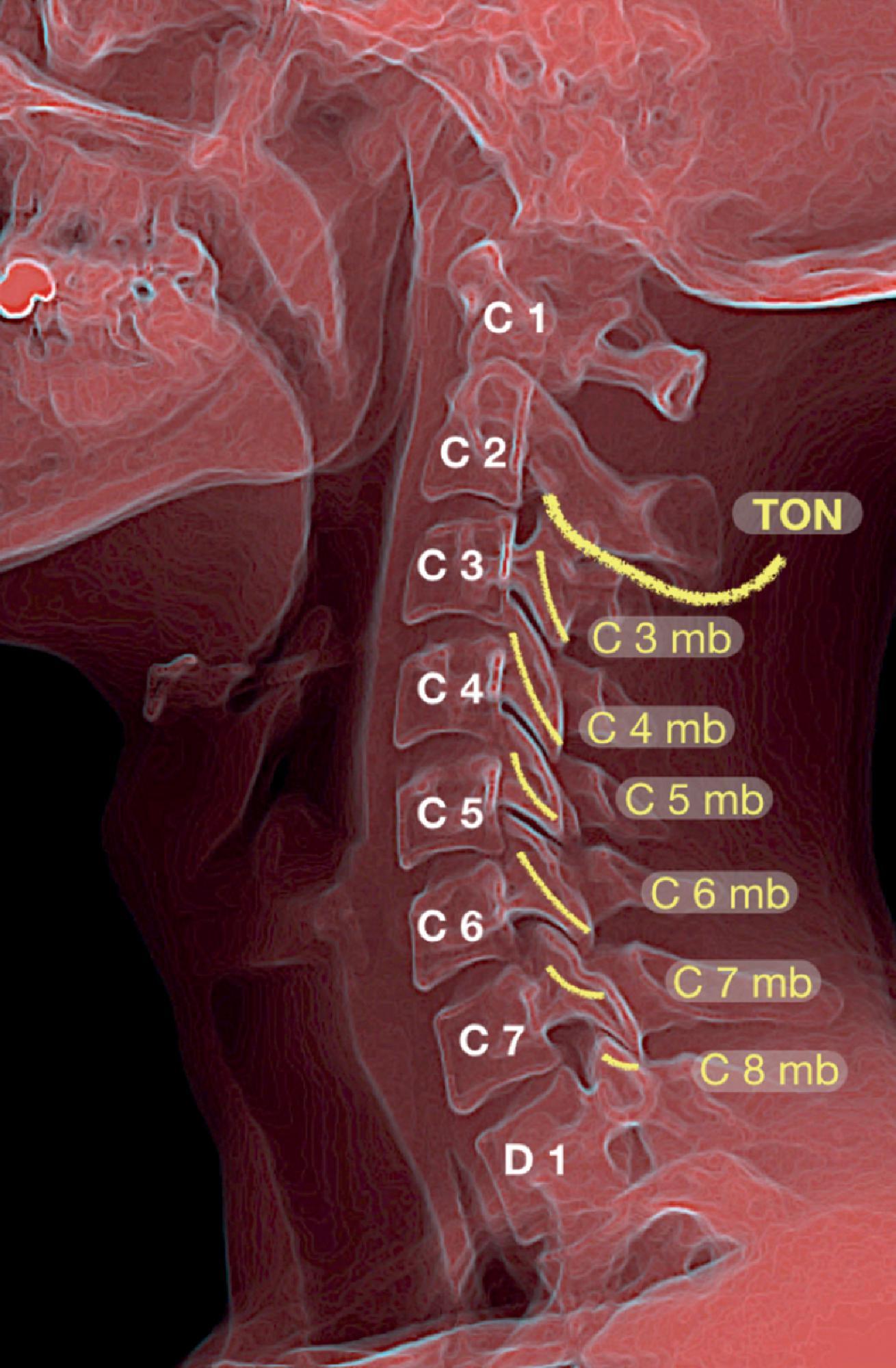
The innervation of C2–3 is slightly more complicated. This uppermost facet joint receives the majority of its innervation from the C3 dorsal ramus. The C3 dorsal ramus is normally divided into two separate medial branches. The larger superficial branch is also known as the third occipital nerve, and the inferior branch is termed the deep medial branch. Some innervation of the C2–3 level is also derived from the C2 dorsal rami, which may form five distinct branches, the largest of which is the greater occipital nerve. , Along with the upper cervical z-joints themselves, the dorsal rami and its branches can be a source of cervicogenic headache. ,
Osteoarthritis (OA) is the most important cause of facetogenic pain. In most cases, facet joint arthropathy is a product of years of repetitive strain and low-grade trauma. This is illustrated by the strong association between facet arthropathy and increasing age. Studies have demonstrated that intervertebral disk degeneration virtually always precedes facet changes in the lumbar spine. In some cases, an inciting event or pathology can be identified, but the etiologic relationship between the identified inciting event and pain is not always clear. For example, in the lumbar spine, Okonkor et al. found that 52% of 1069 patients with positive lumbar facet blocks reported an inciting event, with motor vehicle collisions, sports injuries, and falls being the most common.
Preceding trauma is especially common in the cervical spine, particularly whiplash injuries. , , This can result in chronic neck, head, and shoulder pain secondary to hyperflexion and rotation. , ,
Ianuzzi and coworkers found that joint moments occurring with any given motion correlate with the magnitude of joint displacement and tend to be greatest at the L4–5 and L5–S1 joints. At the three most caudal joints (L3–S1), contralateral bending was associated with greater capsular strain than ipsilateral bending. In contrast, the L1–2 and L2–3 joints undergo greater strain during ipsilateral flexion. For the upper three facet joints, the maximum joint displacement and the greatest strain were associated with lateral bending. For the two lowest joints, the greatest degree of strain occurred during forward flexion ( Table 31.1 ).
| Facet Joint Level | Movement Associated With Maximal IVA | Largest Strain |
| L1-2 | Right bending | Right bending |
| L2-3 | Left bending | Right bending |
| L3-4 | Right bending | Right bending |
| L4-5 | Forward flexion | Forward flexion |
| L5-S1 | Extension | Forward flexion |
Later work provided evidence that spinal fusion can lead to accelerated degeneration at adjacent levels.
The z-joints may respond to repetitive strain and inflammation by filling with fluid and distending, thereby stretching the capsule. Pain from capsular inflammation can spread beyond the joint area because of compression of the exiting nerve root, especially with foramina that are already narrowed by facet joint hypertrophy, osteophytes, or herniated intervertebral disks. Inflammatory cytokines released from facet joint tissue may also contribute to the radicular symptoms in patients with spinal stenosis. Facet joint pain can manifest in a radicular pattern, which is supported by a study that found that the presence of foraminal and central stenosis was positively associated with lumbar medial branch radiofrequency ablation (RFA) outcomes. Irritation of the capsule may also cause reflex spasms of the paraspinous muscles. , ,
Several experiments conducted by groups of investigators established the pathophysiologic basis for persistent lumbar facet pain. These studies showed that injection of pro-inflammatory and algesic mediators into facet joints resulted in inflammatory changes, leading to sensitization of nociceptors. Later work by Chen et al. showed the presence of C and Aδ fibers in the cervical facet joint capsules of goats. C fibers were more prevalent in the dorsolateral aspect of the z-joint capsule, where tendons and muscles attach.
The intervertebral disk and paired facet joints work in concert with changes in any part of the three-joint unit, altering the motion and function of the others. Degenerative disk disease (DDD) has been shown to result in concomitant changes in the facet joints. In the reverse scenario, degeneration and motion abnormalities of the facet joints can induce and accelerate intervertebral disk degeneration. Multiple studies have examined the relationship between DDD and facet joint OA and concluded that DDD generally precedes facet arthritis , , and that facet arthropathy is most pronounced at spinal levels with advanced DDD. ,
The spinal musculature also works collectively with z-joints, controlling movements and stabilizing the vertebral column. , Paraspinal muscles provide proprioceptive feedback for proper alignment and biomechanics. , Aging decreases paraspinal muscle mass, which could compromise these functions and contribute to z-joint OA. Patients with chronic LBP seem to have impaired spinal proprioception and a decrease in paraspinal muscle mass. A study by Kalichman demonstrated an association between decreased paraspinal muscle density and the presence of lumbar z-joint OA, while other conditions that can contribute to or cause z-joint OA include degenerative scoliosis and spondylolisthesis.
Several cases of lumbar facetogenic pain secondary to traumatic dislocation from rapid deceleration injuries have been reported, mostly at L5–S1. , , The purported mechanism of injury in these cases was hyperflexion, rotation, and distraction. Twomey et al. dissected the lumbar spines of 31 patients who died of trauma and noted occult bony fractures in the superior articular process or subchondral bone plate in 35% of subjects and facet capsular or articular cartilage damage in 77% of cases.
For chronic posttraumatic neck pain, the cervical z-joints have been estimated to account for up to 60% of cases. However, trauma is responsible for a relatively small percentage of chronic neck pain, with the prevalence ranging from 13%–42%.
The prevalence of facet joint pain varies greatly in the literature. Among patients with axial spine pain, the proportion of patients with facetogenic pain is higher in the cervical and thoracic regions than in the lumbar region. The problem with estimating the prevalence of facet joint pain is that in the absence of any objective reference standard (e.g. imaging), one must rely on subjective diagnostic procedures such as medial branch blocks or intraarticular injections, which are subject to high technical failure rates (e.g. between 29% and 38% per joint, and from 46% to 64% per procedure in the lumbar spine). There is also a wide variation in the interpretation of blocks (e.g. the threshold of pain relief required to designated a block as positive), with uncontrolled blocks subject to significantly high false positive and false negative rates. Many studies also conflate two different concepts: z-joint arthropathy, which may or may not be painful, and z-joint pain, which may or may not be produced by arthropathy.
The prevalence of LBP stemming from lumbar facet joints is low and is greatly affected by the age of the cohort being tested (i.e. much higher in older individuals) and both the cutoff threshold and number of blocks. In a non-enriched population in which double blocks are employed and cutoff thresholds exceeding 75% are used, the prevalence of lumbar facetogenic pain among individuals with axial LBP is approximately 10%–15%. The prevalence of z-joint-related cervical pain is estimated at 50–55%, increasing to approximately 60% in patients whose neck pain is caused by whiplash. In the thoracic spine, the prevalence is estimated to be between 40% and 50%.
The prevalence of lumbar facetogenic pain is shown in Table 31.2 . Earlier studies (1999–2000) by Schwarzer et al., , , Revel et al., Manchikanti et al., , , and Dreyfuss et al. are not included in the table ( Tables 31.2 and 31.3 ).
| Author, Year | Patients | Interventions | Results | False Positive Rate and Comments |
| Manchikanti et al. 2004 | 397 pts with chronic LBP without neurologic deficits | Pts rec’d MBB with 1% lidocaine. All pts who obtained ≥75% pain relief underwent confirmatory blocks with 0.25% bupivacaine. A (+) response was ≥80% relief lasting longer with bupivacaine. | 198 (50%) of pts obtained a (+) response to lidocaine blocks, with 124 reporting definite pain relief with bupivacaine, for a 31% prevalence rate | FP rate, 27%. Mean age, 47 years. |
| Manchikanti et al. 2007 | 117 consecutive patients with chronic LBP after lumbar surgical interventions | MBB performed with 1% lidocaine, 0.25% bupivacaine, 0.5 mL. At least 80% of pain relief from block. | Prevalence = 16% (9%–23%) | FP rate = 49% (39%–59%).in patients with failed back surgery syndrome |
| Manchukonda et al. 2007 | 303 patients with chronic LBP of at least three months duration following a motor vehicle accident | MBB performed with 1% lidocaine, 0.25% bupivacaine, 0.5 mL. At least 80% pain relief with the ability to perform previously painful movements. | Prevalence = 31% (27%–36%) | FP rate= 27% (22%–32%) |
| Kavita et al. 2008 | Retrospective analysis of 303 patients with chronic lumbar and/or cervical pain divided by age groups (Group I: 18–30 years, II: 31–40 years, III: 41–50 years, IV: 51–60, V: 61–70 years, VI: greater than 70 years old) | Facet joint pain was initially assessed in all patients by diagnostic blocks using 1% lidocaine, followed by 0.25% bupivacaine if the responses to lidocaine were positive on two separate occasions, usually separated by three to four weeks. A positive response was defined as:1) at least an 80% reduction of pain,2) the ability to perform previously painful movements (as assessed using a verbal numeric pain rating scale), 3) pain relief from a block lasting at least 2 h when lidocaine was used and at least 3 h when bupivacaine was used. | The prevalence of facet joint involvement in lumbar spinal pain ranged from 18% (in Group II: 31-40 years) to 44% (in Group IV: 51-60 years), with significant differences noted when Group II and Group III were compared to other groups, and with higher rates in Group V. | Overall FP rate 45% (36%–53%)Group I: 40% (20%–60%)Group II: 50% (26%–74%)Group III: 45% (30%–60%) inGroup IV: 30% (12%–47%)Group V: 64% (43%–84%)Group VI: 43% (16%–69%) |
| Manchikanti et al. 2010 | 181 patients with chronic low back pain | MBB performed with 1% lidocaine, 0.25% bupivacaine, 0.5 mL. Compared, 50% pain relief with 80% pain relief. | 50% pain relief Prevalence = 61% (53%–81%)80% pain relief Prevalence = 31% (26%–35%) | 50% pain relief FP rate = 17% (10%–24%)80% pain relief FP rate = 42% (35%–50%) |
| DePalma et al. 2011 | Retrospective evaluation of 156 patients with CLBP were assessed for the source of chronic LBP (discogenic pain, facet joint pain, and sacroiliac joint pain) | MBB performed with 1% lidocaine, 0.5% bupivacaine.Concordant relief for 2 h for lidocaine and 8 h for bupivacaine with 75% pain relief as the criterion standard | Prevalence = 31% | Study evaluated various structures implicated in LBP with controlled diagnostic blocks |
| Author, Year | Patients | Interventions | Results | False Positive Rate and Comments |
| Barnsley et al. , 1993 | 47 pts with chronic neck pain >3 months after MVA | Pts rec’d cervical MBB with 0.5 mL of either 2% lidocaine or 0.5% bupivacaine. Pts with positive block rec’d other agent. A (+) response required longer pain relief with bupivacaine. | 27 pts had longer relief with bupivacaine than with lidocaine, for a 60% prevalence rate. | 13 pts (27%) had a (+) response to both LAs but in excess of the expected duration. Average age, 41 years. Female-male ratio, 1:1. All but three pts involved in litigation. |
| Barnsley et al. 1995 | 50 pts with chronic neck pain of >3 months duration after a whiplash injury from MVC | Pts rec’d cervical MBB with 0.5 mL of either 2% lidocaine or 0.5% bupivacaine at random. Pts with a (+) block rec’d the complementary anesthetic. A (+) response required longer pain relief with bupivacaine. | 27 pts who completed the study met the criteria for a (+) painful joint, for a 54% prevalence rate. | Ten pts (20%) had longer pain relief with lidocaine than with bupivacaine or no pain relief with repeated blocks. Average age, 41 years. Female-male ratio, 1.5:1. C2-3 and C5-6 most frequently affected levels. |
| Lord et al. 1996 | 68 pts with chronic neck pain of >3 months duration after a whiplash injury from MVA | Pts rec’d diagnostic C2-3 blocks to rule out those with third occipital headache. Placebo-controlled cervical facet blocks below C2-3 were done with 0.5 mL of either 2% lidocaine or 0.5% bupivacaine. If (−), other levels were then attempted. If (+), pts rec’d either NS or other LA at random and then had a third block with the remaining agent. | 31 of 52 pts (60%) who completed the study had cervical facet pain at C2-3 or below, for a 60% prevalence rate. Among pts with HA as the dominant Sx, 50% prevalence of C2-3 facet joint pain. In pts without C2-3 facet pain, the prevalence of lower cervical facet pain was 49%. | Average age, 41 years. Female-male ratio, 2:1. C2-3 and C5-6 most commonly affected levels. |
| Manchikanti et al. 2002 | 46 pts with chronic thoracic pain (>6 months) without neurologic Sxs | Pts rec’d MBB with 1% lidocaine followed by confirmatory blocks with 0.5% bupivacaine. A (+) response was ≥80% concordant pain relief. | 22 of 36 pts with (+) lidocaine blocks had longer relief with confirmatory bupivacaine blocks, for a 48% prevalence rate. | FP rate, 58%. Average age, 46 years. |
| Manchikanti et al. 2002 | 106 pts with chronic neck pain with or without HA or upper extremity pain | Pts rec’d diagnostic blocks with 0.5 mL of 1% lidocaine followed by 0.5 mL of 0.25% bupivacaine two weeks apart. | 64 of 81 pts with (+) lidocaine blocks had longer relief with confirmatory bupivacaine blocks, for a 60% prevalence rate | 40% FP rate. Mean age, 43 years. Female-male ratio, 2:1. 15% of pts had previous neck surgery. |
| Manchikanti et al. 2004 | 500 pts with chronic neck, thoracic, and/or LBP without neurologic Sxs. 255 pts had cervical Sxs, and 72 pts had thoracic Sxs | Pts rec’d MBB with 1% lidocaine followed by confirmatory blocks with 0.25% bupivacaine. A (+) response was ≥80% relief lasting longer with bupivacaine. Minimum of two levels blocked based on pain patterns. | 55% prevalence rate of cervical facet joints in pts with cervical spine pain. 42% prevalence rate of thoracic facet joints in pts with thoracic pain. | FP rate of 63% for cervical and 55% for thoracic MBB. Average age, 47 years. Female-male ratio, 2:1 for both cervical and thoracic. |
| Manchukondet al. 2007 | 251 patients with chronic neck pain of at least six monthsduration. Non-specific with no radicular component | 1% lidocaine0.25% bupivacaine0.5 mL volume | Pain relief ≥80% with the ability to perform previously painful movements | Prevalence = 39% (32%–45%)FP rate= 45% (37%–52%) |
| Yin and Bogduk 2008 | 84 patients with chronic neck pain of at least three months duration | 4% lidocaine0.75% bupivacaine 0.5 mL | 100% pain relief with duration of response concordant with the anesthetic used | |
| HA , headache; MVC , motor vehicle collision; MVA , motor vehicle accident; Sxs , symptoms. | ||||
Facetogenc pain tends to be insidious and progressive, except for whiplash injuries that follow an acute, traumatic event. , Young patients with LBP or neck pain are more likely to present with centralized pain that is more indicative of disc disease, while older patients are more likely to have facetogenic pain as the primary pain generator. The direct association with age is consistent with the concept that facet pain is a chronic degenerative disorder that coexists with DDD rather than an acute inflammatory process.
The distribution and radiation of pain from the facet joints have been derived from relief with LA blocks, pressurization of the facet joints, and stimulation of the medial branches innervating the specific joints. The majority of these studies have failed to demonstrate any reliable pain referral patterns.
An important part of the clinical workup is differentiating z-joint pain from other sources of pain. , A study by DePalma et al. demonstrated that the presence or absence of thigh pain significantly correlated with the source of chronic LBP for varying ages (i.e. thigh pain increased the likelihood of facetogenic vs. discogenic pain in older people). In contrast, the presence of hip/girdle pain or leg pain did not discriminate between discogenic pain, z-joint pain, or sacroiliac joint pain. As previously noted, discogenic pain was more prevalent in younger patients, while z-joint pain was more prevalent in the elderly.
When the existing data are synthesized, certain pain patterns emerged ( Figs 31.4 – 31.6 ). The joint capsule appears to be more likely to generate pain than the synovium or articular cartilage. A great deal of overlap exists between neighboring facet joints and between discs and facet joints. All lumbar levels are capable of producing groin pain, which is most common at lower levels. , , , , Pain from the upper lumbar facets tends to extend into the flank, hip, and upper lateral aspect of the thigh, whereas pain from the lower lumbar levels is likely to penetrate into the thigh, usually laterally and posteriorly. Infrequently, the L4–5 and L5–S1 facet joints can provoke pain in the lateral part of the calf and rarely in the foot. Patients with osteophytes, synovial cysts, or facet hypertrophy may also have radicular symptoms. Unilateral pain or pain in the paraspinal distribution is more likely to be associated with pain from the facet or sacroiliac joints than with discogenic LBP.
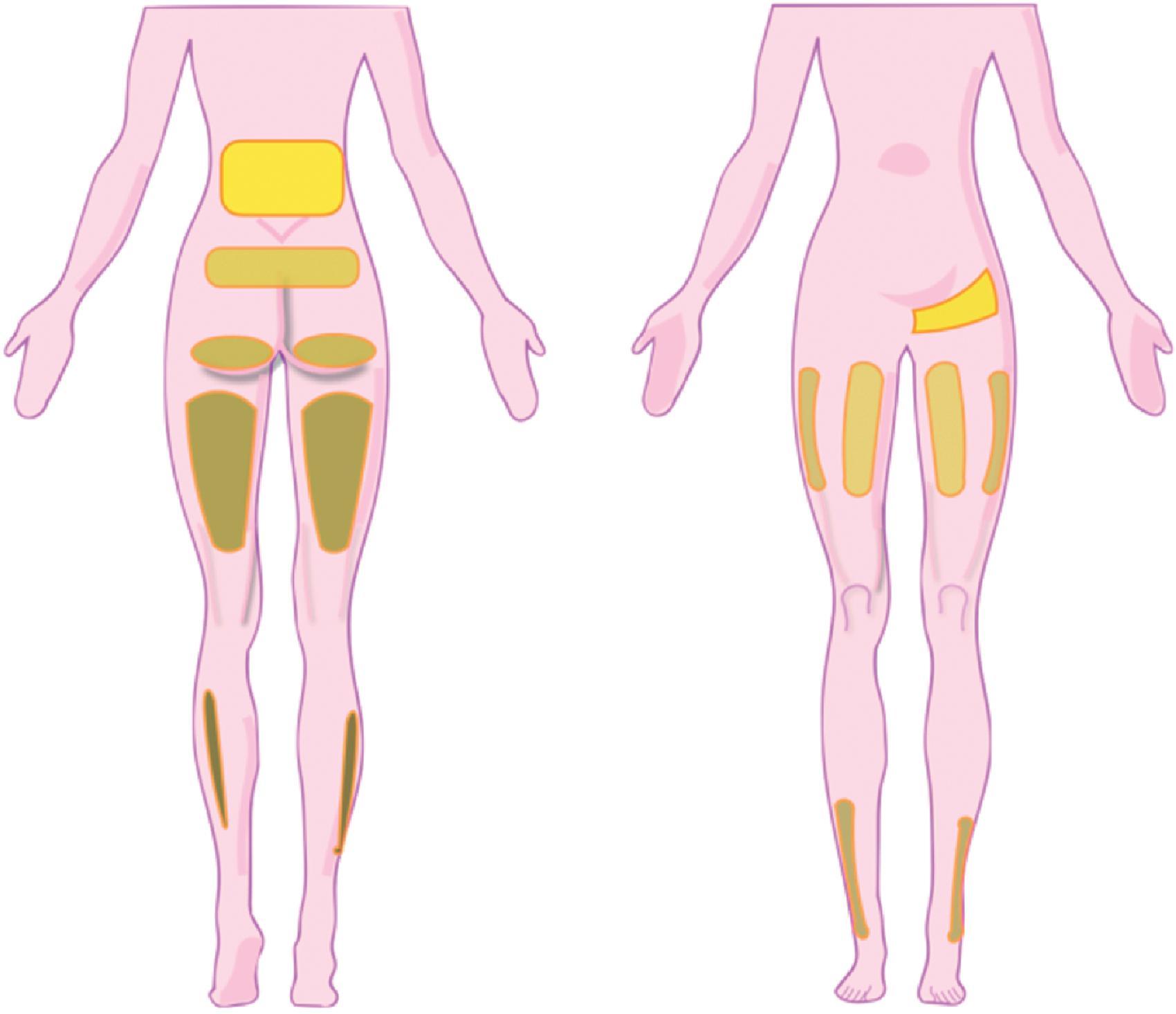
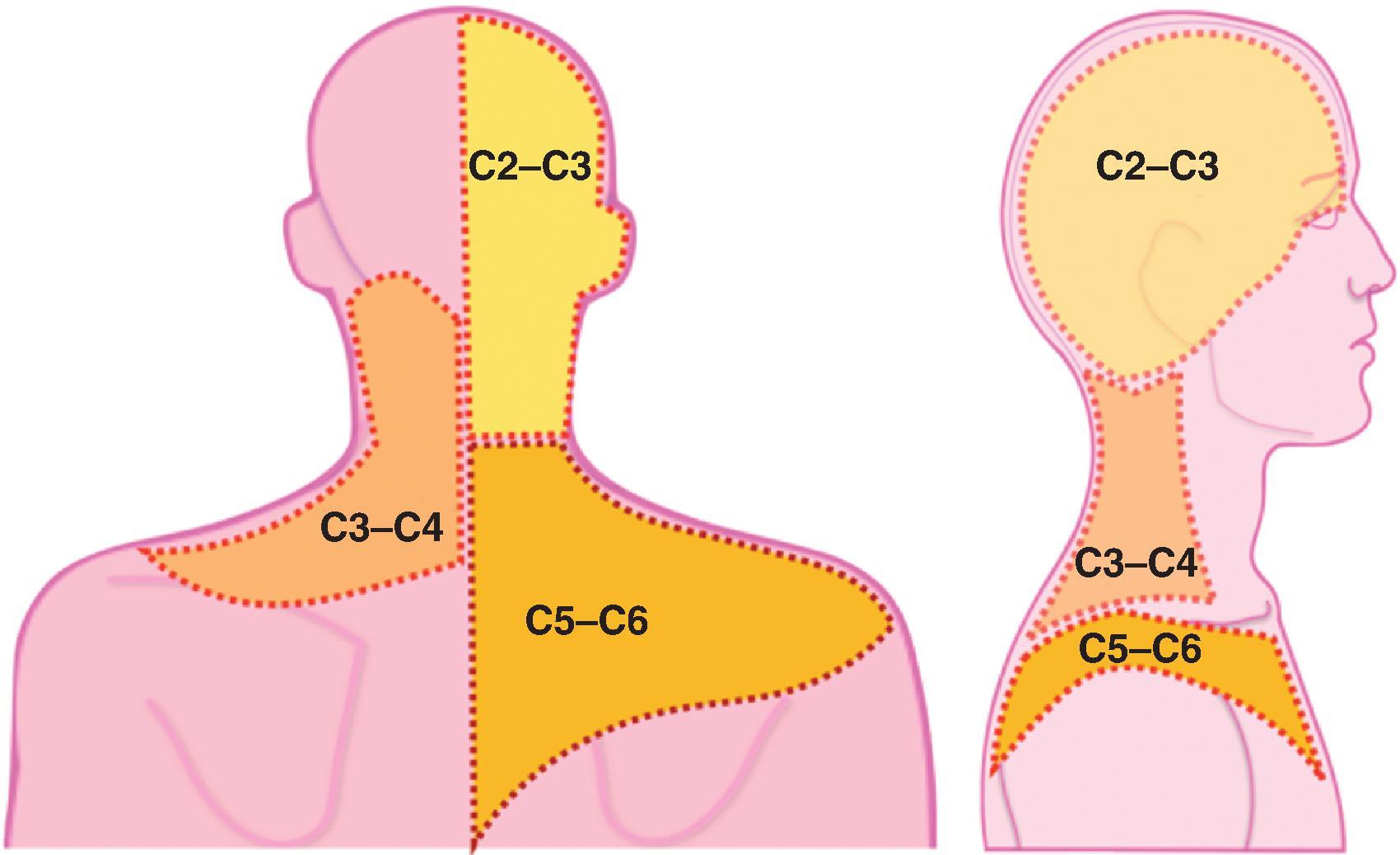
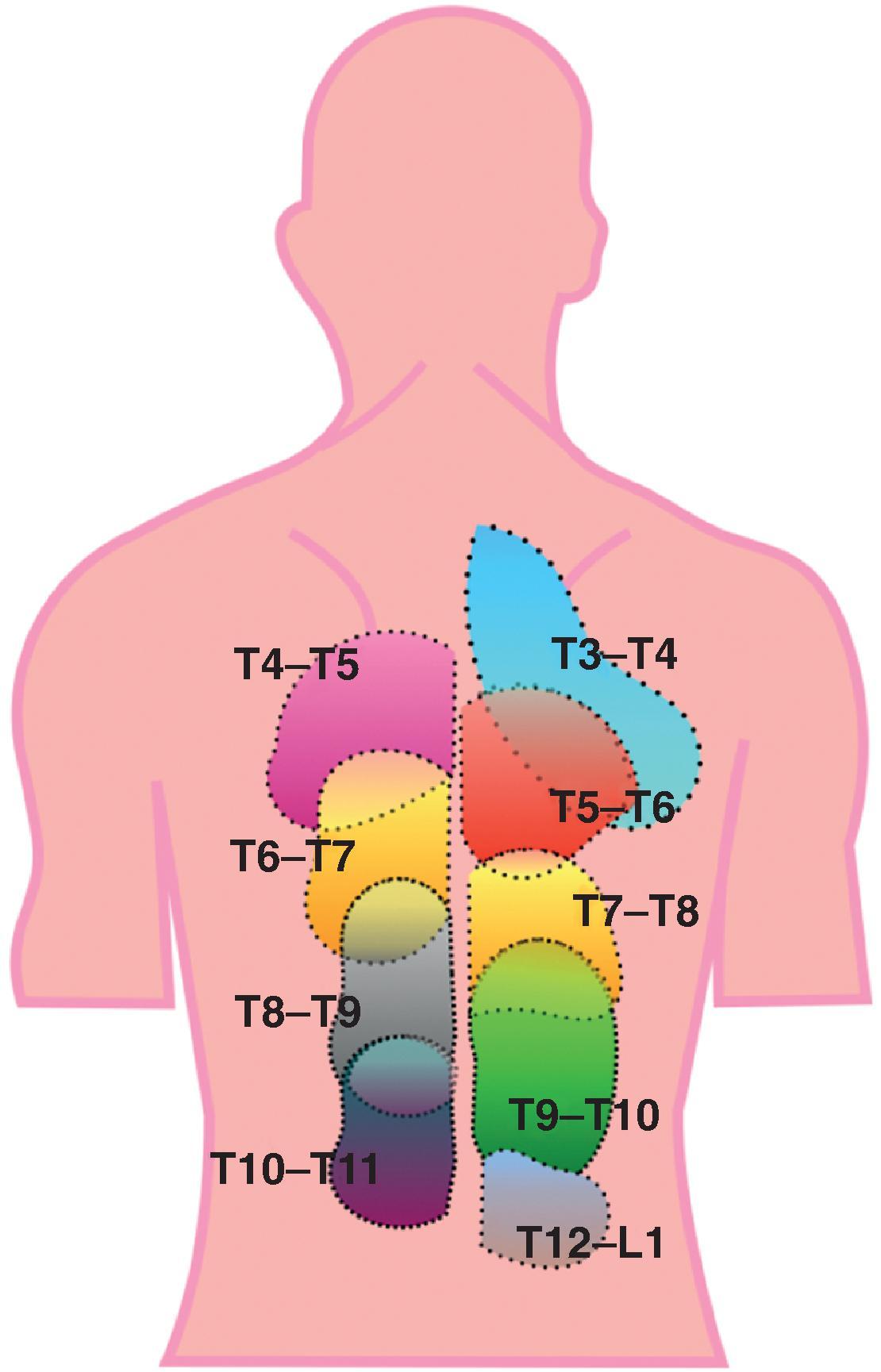
Clinical studies have been conducted in normal volunteers and patients with suspected cervical facet pain to determine pain referral patterns. From C2–3, the pain pattern generally extends rostrally to the upper cervical region and suboccipital area. Infrequently, symptoms extend toward the ear or further up the scalp. From C3–4, pain is referred to the upper and middle posterior aspect of the neck, with occasional radiation to the lower occiput. From C4–5, the most common referral pattern is to the lower posterior cervical region, although in many people, it extends to the middle posterior aspect of the neck and suprascapular region. Pain from C5–6 typically radiates to either the suprascapular region or lower part of the neck but sometimes extends to the shoulder joint or midposterior neck region. From C6–7, pain is usually referred to the upper or lower neck area. Pain from the C7–T1 z-joint most frequently extends further down into the midscapular area.
Other joints that can cause cervical pain or headaches are the atlanto-occipital joint and atlanto-axoid joints. Both show highly variable patterns, which may extend over the suboccipital region and the head and face.
Similar work has been done for thoracic z-joints. The pain referral patterns were as follows: pain from the C7–T1 and T1–T2 z-joints typically radiate into the suprascapular region and superior angle of the scapula. Pain extending into the midscapular region may originate from either C7–T1, T1–2, or T2–3, and pain from the T11–12 z-joint generally extends into the paravertebral region around the site of injection around the iliac crest area ( Fig. 31.6 ). ,
As with historical findings and pain referral patterns, physical examination has limited value in diagnosing facet pain and is more valuable in ruling out other causes of pain. Among the available physical examination findings, the presence of paraspinous muscle tenderness on palpation is probably the only sign weakly indicative of facetogenic pain. , This finding is likely because of sensitized musculature rather than actual strain on the facet joints.
Despite the limited value of physical examination in diagnosing facet pain, many research studies and clinicians still rely on provocative maneuvers to select patients for facet interventions. A study showed that patients who responded to intraarticular injections were more likely to have back pain associated with groin or thigh pain, paraspinal tenderness, and reproduction of pain with extension rotation maneuvers. Pain radiating below the knee was a negative predictor.
Larger and more methodologically sound studies have failed to validate “lumbar facet syndrome” or the provocative maneuver commonly known as “facet loading.” Prospective studies of patients with chronic LBP could not correlate any historical or physical findings associated with a positive response to facet injections. , In both studies, only a small percentage (10% and 15%, respectively) of patients responded to diagnostic blocks. A randomized, placebo-controlled study of 80 patients with chronic LBP by Revel et al. found seven factors to be associated with response to facet joint anesthesia: age older than 65 years and pain not exacerbated by coughing, not worsened by hyperextension, not worsened by forward flexion, not worsened when rising from forward flexion, not worsened by extension rotation maneuvers, and well relieved by recumbency. However, subsequent investigations failed to corroborate these findings.
Very few studies have investigated the history and physical findings most consistent with cervical and thoracic facet pain. One study found that a blinded therapist specializing in manipulation could correctly diagnose symptomatic cervical facet joint pain in patients with positive diagnostic cervical MBBs through the perceived passive displacement of the joint and its resistance to displacement. However, a subsequent study conducted using controlled blocks as the “gold standard” for cervical z-joint pain found that although manual examination had a sensitivity of 88%, low specificity (39%) precluded its use as a valid diagnostic tool. The majority of cervical facet prevalence studies have been conducted on whiplash victims, thereby making it difficult to draw conclusions in non-trauma patients. A Delphi study from an expert panel identified 12 indicators of lumbar joint pain. Those that reached the highest levels of consensus were a positive response to facet joint injection, localized unilateral LBP, positive medial branch block, paraspinal tenderness, absence of radicular features, pain eased by flexion, and pain, if referred, located above the knee. A study by Laslett found seven characteristics suitable for selecting patients for interventions involving the lumbar z-joints: 1) age 50 years or greater, 2) pain relieved when walking, 3) pain improved by sitting, 4) paraspinal pain predominance, 5) Modified Somatic Perception Questionnaire score exceeding 13, 6) positive extension rotation test, and 7) absence of centralization during repeated movement testing. Recently, a meta-analysis by Usunier et al. identified four clinical tests that predicted cervical facet joint pain: passive intersegmental motion testing; mechanical sensitivity; pain consistent with cervical zygapophyseal joint referral patterns; and, based on a single study, a positive extension rotation test. However, the sensitivity and specificity of these tests were poor.
Become a Clinical Tree membership for Full access and enjoy Unlimited articles
If you are a member. Log in here